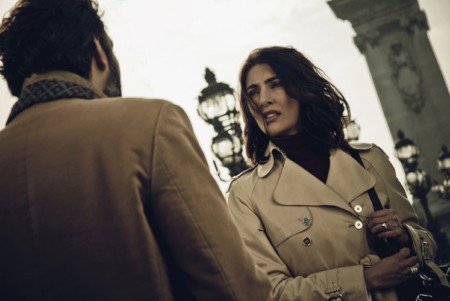The Story of My Life (Ferriere, 2009): France
Reviewed by Skylar Harrison. Santa Barbara International Film Festival, Victoria Hall as part of the Shorts Program 2.
 The Story of My Life (Toute Ma Vie), written and directed by Pierre Ferriere, is a short French drama filled with intense intrigue, picturesque cinematography, and the finest attention to detail (from the perfect music to the most poignant camera movements). The Story of My life, in its brief six minute running time, did not overcompensate for brevity with obvious dialogue or plot. Just as in any worthy feature film, the themes, narrative and character dynamics are not told, but shown. Catherine Murino (Casino Royale) and Vincent Desagnat—a French Ben Stiller—were precisely cast and carried the two actor short with believability.
The Story of My Life (Toute Ma Vie), written and directed by Pierre Ferriere, is a short French drama filled with intense intrigue, picturesque cinematography, and the finest attention to detail (from the perfect music to the most poignant camera movements). The Story of My life, in its brief six minute running time, did not overcompensate for brevity with obvious dialogue or plot. Just as in any worthy feature film, the themes, narrative and character dynamics are not told, but shown. Catherine Murino (Casino Royale) and Vincent Desagnat—a French Ben Stiller—were precisely cast and carried the two actor short with believability.
The short starts with a naively romantic (it is Paris after all) pan of what could to be Le Seine. The shot, filled with natural sunlight reflecting off of the river and English love song lyrics resonating through the air, sets the film up as simply beautiful, which effectively juxtaposes the coming plot. As Allesandra (Murino) strolls down a riverside bridge, she glowingly informs her husband, via telephone message, that she is not expecting one child but two. However, Allesandra is pulled back to reality when a male stranger (Desagnat) calls her name.
Although the mysterious stranger insists that they know one another, Allesandra is sure she has never seen the man. In the progressing dialogue, the stranger goes from a charming could be acquaintance to unstable stalker, as he literally lists off everything about Allesandra’s life from tragic events to insignificant details. Just as the title suggests, this short covers Allesandra’s whole life in four minutes of dialogue in a completely captivating manner. It is when the stranger brings up the school bus accident that only Allesandra survived that the audience loses all trust in the all knowing character.
The cinematography and editing of the film is tastefully simple and stunning. With a sepia hue, the visual aesthetic of the film captures a French romance, yet the editing combined with the dialogue suggests something different—this is not a romance, but a drama about whether an obsessed almost God-like stranger can play a person like a puppet. The shots cut back and forth between the two characters conversing, engaging the audience in the most important aspect of the film: the conversation. The simple back and forth editing also makes the smoother camera movements all the more effective. In the most chilling shot of the film, the camera slowly pulls back from the stranger, he then turns and walks out of the frame. Because the editing and camera work is simply, it allows the audience to focus on the subtle themes and ambiguous quest and motives of the stranger.
The music of the film, although only present in the opening river shot and at the end credits, plays a very significant part of the film, foreshadowing the ending and Allesandra’s fate. The music in fact, captures the whole essence of the film: on the outside it may seem caught up with the poetic-ness of love, but if you look closer, death is a major theme. The singer and lyricist, Moira Conrath, breezily sings, “For you I’d die again.”
Beautifully shot and realistically acted, you do not want this short to end. Lucky for us, it will soon be written into a feature film. Within a brief time, Ferriere does something remarkable: fully creates a short with themes of life and death at the core, yet he does it in a subtly indirect way. It is up to the viewer to decide exactly whom the chilling stranger is—a coincidence or a man attempting to play God?
About this entry
You’re currently reading “The Story of My Life (Ferriere, 2009): France,” an entry on Student Film Reviews
- Published:
- 02.19.10 / 8am
- Category:
- Films, Santa Barbara Film Festival 2010
1 Comment
Jump to comment form | comments rss [?] | trackback uri [?]